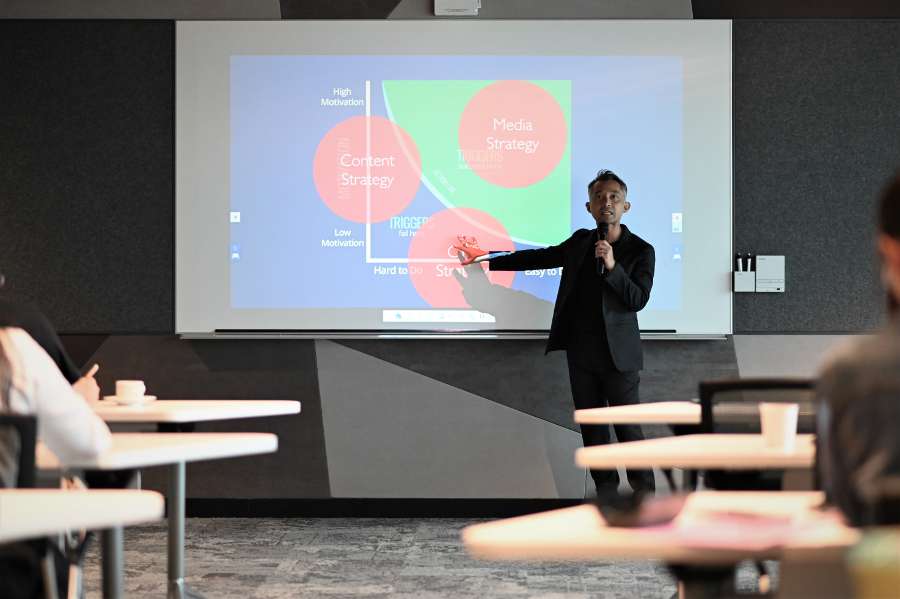I WANT
RELATED LINKS
I WANT
RELATED LINKS
RELATES LINKS
I WANT
RELATES LINKS
Services
Related Links
Use and Management of Cookies
We use cookies and other similar technologies on our website to enhance your browsing experience. For more information, please visit our Cookies Notice.
- Personal Banking
- Stories & Tips
- BUSINESS MAKER
- Unleash the Power of Storytelling –A Path to the Creation of Brand
- Personal Banking
- ...
- Unleash the Power of Storytelling –A Path to the Creation of Brand
Unleash the Power of Storytelling –A Path to the Creation of Brand
20-11-2019
Storytelling is an important factor of content marketing. It is a marketing strategy that allows service and products to moderately win the heart of the consumers without their resistance. This is because, fundamentally, people dislike things to be forced into them.

In NIA-SCB IBE – Innovation Based Enterprise Course by NIA and SCB, Mr Sutirapan Sakkawatra, EVP, Head of Marketing from Siam Commercial Bank, reveals the power of storytelling that can magically convince people.
The Heart of Marketing is to Search for Possibilities
From “Fogg Behaviour Model Theory”: B = MAT, Mr Sutirapan concluded the core of marketing that the action of buying or ‘B’, which stands for Behaviour, can happen if these 3 factors happen, namely, Motivation, Ability, and Trigger. When these 3 factors come together perfectly, the area above the graph B = MAT is the possibility that people will purchase the product. The duty of a marketing expert is to find the potential customers in the area of possibility, find the right person/right customer, or shift people from below the graph to above the graph.

Key to Trigger Customers
It might appear that B = MAT graph is not complicated, however, practically, solution cannot be obtained easily if there is no complete understanding of the marketing strategy. Mr Sutirapan explained on the marketing strategy that will be the key to solve the problem of “why customers are not triggered?”
1) Media Strategy: There must be a consideration of whether the methods of conveying the message can get through the target group. There are 3 types of media which are Paid Media, Owned Media, and Earned Media. Paid Media (Display Ad, Search Ad, and Native Advertising) and Earned Media (Conversation, Brand Placement, Blogs, and Social Network) will help to establish Brand Awareness. As for Owned Media (Website, Branded Content, Social Pages), it will create Brand Experience for consumers. Nevertheless, sending a message to the market must be done in an appropriate manner to reach the relevant target group, so that the desired result can be obtained.

2) 1. Call to Action or CTA: A strategy that improves “A: Ability to do” is to make the buying process as easy as possible. For example, CTA of bank business in the past is to go to branches to enquire about account-related issues and it took much effort from the consumers. Later on, CTA was moved to call center, website, and eventually, e-banking. Just like SCB that CTA, such as a request for a loan, apply for the credit card, open an account, etc, can be done through SCB EASY APP anywhere and anytime. This can be seen that good CTA can actually help to improve the business situation.
3) Content Strategy: A strategy to convince consumers to increase the motivational levels in buying. It will change cold customers to warm customers and when the motivational level has reached its peak, they will turn into hot customers that are ready to buy products when received the message with a suitable media strategy.

“Start with Why”
Let us go in-depth in content strategy, Mr. Sutirapan took Jordan Belfort, a former stockbroker, as an example. Belfort’s story was featured in the movie “The Wolf of Wall Street”. His selling topic is “Sell me this pen”. Most of the people will start the conversation with the properties of this pen, for example, this is a beautiful pen or this is a high-quality pen which is a “Start with What” story. However, effective selling is to start the conversation with ‘Why’, giving reason the pen should be bought. This is a process of creating demand or increasing the level of motivation in buying with storytelling.
The powerful storytelling is to tell the story of the identifiable victims, not just statistical victims. For instant, the fundraising for unfortunate children in Africa, the heart-wrenching story of Rokia, an 8-year-old unfortunate African girl will be able to raise more money compared to the true story of millions of African children lacking food.
Why is it so? According to the experiment, a tragic story of a Russian lady was recorded and her brain was scanned to observe how it functions while she is telling the story. When the story was translated into the English language and shown to Americans to watch, their brains were scanned to see how they function while listening to the story. The result came out that American listeners’ brain function similar to the Russian lady’s. This shows that there is a connection between the story told and the human brain. What follows is the feeling of trust and story is better remembered. If this was to explain in scientific term, the amygdala will release chemical to cover the frontal lobe which makes people use emotion more than reason. Storytelling, in the marketing aspect, is the creation of images in people’s minds, making use of the amygdala to trigger emotions, allowing customers to ‘feel’ the story and remember the message that the brand wants to convey.

Marketing is to Transform People
Mr. Sutirapan sees the customer journey of each product as unique. Different groups of products will have different customer journeys. The most important thing lies upon the principle of Trigger/Motivation/Ability that changes customers in each step from Awareness > Consideration > Purchase > Retention > Advocacy. Mr. Sutirapan emphasizes that “marketing is to transform the human mind with marketing techniques. From dislike to like, from indifferent to love, from unwanted to needed. These can be achieved by utilizing attractive content.” This kind of content will have to match the main theme of the product (Emotional/Rational) and the desired marketing goal at that time which varies from creating Awareness to Purchase. For example, in the creation of Awareness, if the selling point of the product is based on emotion, the content has to be entertaining like viral clips or quiz games. In the creation of purchase, however, the content should be inspiring to lead people to buy the product like review endorsement, etc. If it is a product with rational selling point, like a high-valued product, educational content like articles, info-graphic, trend report or demo video, should be used. Awareness creation will be a convincing content like rating, case studies, product features, datasheets, etc.

‘Why Buy’ can be created with ‘Good Story’
The good story consists of 3 factors which are the beginning, the ending, and the ability to change people with the theme as the heart of the story. Also, it should come with a strong plot, and the plot that will most affect people will be a “life story” that will break people’s hearts and heal them. The story can start from a completely normal day along the happiness line. Suddenly, calamity strikes. Happiness just collapses and no matter how much one tries to get back up, they just keep falling down and hurts even more badly. Then the story comes to the peak where there seems to be no hope, but the magical power or the solution to the problem is found and used to bring back peace or happiness again. There comes a happy ending.
Plot consists of:
- Protagonist: a center of the story that allows the story to happen, evolve, and end. This could be human or things that listeners will care for and cheer for.
- Antagonist: a person, a thing, an action, a process, or whatever that opposes the protagonist is considered an antagonist. Someone or something that listeners would want to help get rid of.
- Desire: everybody has their own desire. They will do whatever it takes to obtain it and that is where the problem arises.
- Missing Piece: an important thing that is missing. The search for this missing piece will bring about change and the journey starts.
- Turning Point: an important event that makes problems arise. An event or thing that will change the character at that place and time. A point where the character starts to have a desire.
- A Journey: a process to transform the protagonist, fulfill the missing piece, and search for their own desire.
- Crisis: a point where hope is hardly found. A point where a character will have to choose between moving on and giving up. A moment that listeners will go “Oh No!”
- Climax: a showdown between a protagonist and antagonist. It could be a scene in the meeting room, boxing ring, stadium, etc. It is an important moment like making a speech or facing an obstacle.
- Conclusion: a light at the end of the tunnel. A return of happiness. A revelation of all feelings. A knot unties. The problems are all solved.

From ancient times, “human is a hunter during the day and a storyteller during the night”. The mural painting on the cave wall is pictorial evidence of how the ancestors passed down the story of hunting to the rest of the group members. Later on, it developed into a language that expresses thoughts and knowledge to society. Mr. Sutirapan concluded the power of storytelling that the successful leaders of the religions and politicians are all great storytellers because storytelling has the power to transform people and this makes storytelling an important tool to create widespread content marketing in present society.
#SCBNIA #SCBIBE #SCBSME
#SCBWITHPURPOSE
